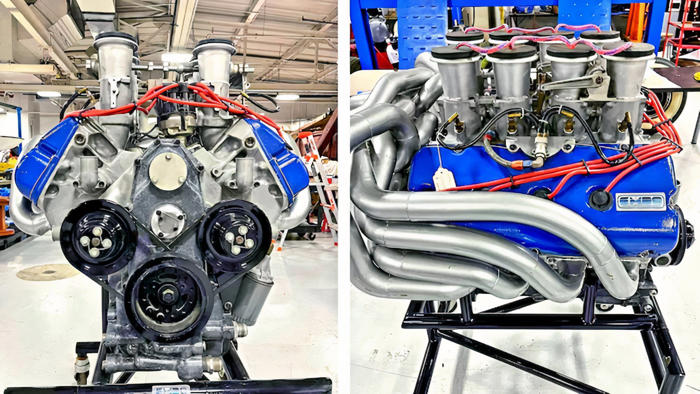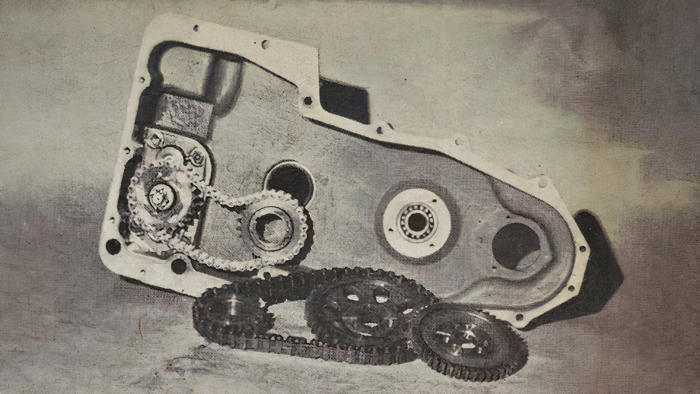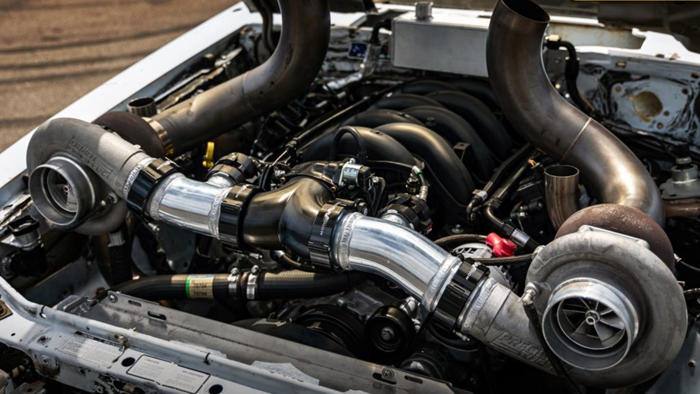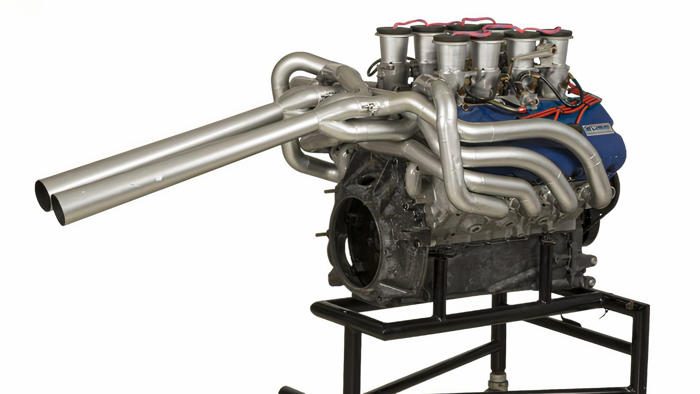History And Mystery Of The Rarest Ford Big Block Ever Built
- The Ford Calliope V-8 is a legendary engine that was developed in the late 1960s as part of Ford's quest to dominate Le Mans racing.
- The Calliope's innovative features included a three-valve per cylinder layout, integrated throttle bodies, and a twin-camshaft arrangement.
- Despite its promise, the Calliope's journey was cut short by the FIA's decision to limit engine displacement to 183 cubic inches, effectively sidelining the Calliope before it could demonstrate its capabilities in a competitive setting.
The history of automotive engineering is filled with fascinating tales of innovation, competition, and, occasionally, heartbreak. Among these stories, the Ford Calliope Big Block V-8 stands out as a particularly interesting story. Known as the "holy grail" of Ford's big blocks, the Calliope was an experimental engine that promised unparalleled performance.
However, despite its potential, it was ultimately banned before it could revolutionize the racing world. This article delves into the origins, technological marvels, and untimely demise of the Calliope V-8, providing a good understanding of why this engine remains a mysterious legend of the automotive world.
When HotRod Magazine introduced Ford's Calliope engine to the public on the cover of the June 1968 issue, it was already surrounded by an aura of mystery and controversy. The engine, designed for Le Mans to power the GT40, was expected to dominate with its extraordinary power and innovative design. Unfortunately, the FIA's decision to outlaw engines over 183 cubic inches abruptly halted its development.
Despite this setback, the Calliope's advanced engineering—such as its unique cylinder head design and potential for huge horsepower—ensured that it was not completely forgotten. Throughout the article we will explore how the Calliope managed to achieve such remarkable power, the reasons behind its ban, and how it continues to inspire enthusiasts and engineers today, including efforts to recreate this piece of automotive history.
In order to give you the most up-to-date and accurate information possible, the data used to compile this article was sourced from Ford as well as other authoritative sites, including HotRod Magazine for their original cover release.

A parked Ford GT40
Related
The Professional Street Track Racer That Made History: 1964 Ford GT40
The GT40 was an endurance racing machine created by Shelby and Broadley to beat Ferrari. A machine that deserves respect on and off the track!
The Ford Calliope Big Block V-8 Is The Holy Grail

Ford Calliope Big Block LeMans V8
The Ford Calliope big block V-8, often referred to as the "holy grail" among Ford enthusiasts, was a moment of righteous engineering and ambition. This experimental engine, developed during the height of Ford's competitive Le Mans spirit in the 1960s, was designed to push the boundaries of performance. With its unique design, the engine had a 4.34-inch bore and a 3.60-inch stroke, which pushed the Calliope to produce an astonishing 630 horsepower at 6,300 RPM. The innovative engineering didn't stop there—the Calliope also featured a semi-hemi pent-roof cylinder head design and a twin-camshaft arrangement, which contributed to its impressive power and efficiency.
The Calliope's potential was not just theoretical; it was confirmed through rigorous dyno-testing and even made its way into a Can Am test vehicle. The engine's distinctive appearance, with its bundle of snake-like 180-degree header arrangement, earned it the nickname "Calliope," reminiscent of a steam-powered musical instrument. Despite its promise, the Calliope's journey was cut short by regulatory changes in racing, leaving only a few prototypes and a legacy that continues to captivate car enthusiasts and automotive historians.
Le Mans Racing V-8
The Calliope was born from Ford's relentless drive to dominate Le Mans racing. After Ford's victorious 1966 Le Mans campaign, the company sought to create an engine that could sustain its winning streak. Sharing its 4.90-inch bore spacing with the 385 Series "Lima" big-block, the Calliope featured a 4.34-inch bore and a 3.60-inch stroke, resulting in a displacement of 426 cubic inches, or 427 if you are a die-hard Ford fan. The Calliope's advanced technologies, including a unique valve actuation system, allowed it to achieve up to 800 horsepower and a redline of 8,000 rpm, making it a revolutionary force in the racing world.
Never Reached The Track
The Calliope's story is one of unfulfilled potential. Despite the significant investment and progress made in its development, the engine never had the opportunity to compete on the racing circuits it was designed for. The FIA's ruling to limit engine displacement to 183 cubic inches was a strategic move to curb the dominance of American V-8s in European racing. This decision effectively sidelined the Calliope before it could demonstrate its capabilities in a competitive setting.
However, the Calliope did not simply disappear into obscurity. One of the three built engines found its way into the Henry Ford Museum, where it captured the attention of automotive enthusiasts and historians. The remaining engines, along with casting cores and other parts, became the focus of restoration and reproduction efforts by passionate individuals like Dan Schoneck.

Custom Ford GT40 Build
Related
This Custom Ford GT40 Build Is A Tribute To Dedication And Desire
Few cars have captured the hearts of car enthusiasts like the Ford GT40. You'll love this custom Ford GT40 built by Benjamin from BenjaminWorkshop.
How Did The Calliope V-8 Make So Much Power?

Ford
Ford’s Calliope V-8’s impressive power output stemmed from its massive sizing, it is a big block after all. Its 426 cubic inch displacement was achieved through a 4.34-inch bore and a 3.60-inch stroke, coupled with an aluminum block featuring iron cylinder liners. The engine's cylinder heads were a standout feature, with a three-valve per cylinder layout, including two 1.655-inch intake valves and one 1.809-inch exhaust valve, which allowed for greater airflow and combustion efficiency.

google news icon large
Add TopSpeed to your Google News feed.
Follow On
Google News
The eight individual throttle bodies for the Hilborn-style fuel injection were integrated into the aluminum cylinder heads, eliminating the need for a traditional intake manifold and optimizing fuel delivery. Additionally, the Calliope’s 180-degree exhaust system further enhanced its performance by improving exhaust flow, contributing to its ability to produce 630 horsepower at 6,400 rpm during early dyno testing.
Capable Of 800 Horsepower
Ford engineers believed the Calliope V-8 had the potential to reach up to 800 horsepower, a massive feat for a N/A engine from the 60s. The engine's aluminum construction and innovative valve arrangement played crucial roles in achieving such high power output. The use of copper rings to seal the bores instead of traditional head gaskets ensures more reliable and robust sealing under high-performance conditions.
The high-density intake charge facilitated by the three-valve per cylinder layout and the direct integration of throttle bodies into the cylinder heads allowed for more efficient air and fuel flow. These features, combined with a careful design that minimized weight and maximized efficiency, positioned the Calliope as a revolutionary engine capable of unprecedented power levels for its time.
Three Valve Heads And Two Camshafts
One of the most remarkable aspects of the Calliope V-8 was its three-valve cylinder head design and unique camshaft arrangement. Each cylinder had two 1.655-inch intake valves and one 1.809-inch exhaust valve, a configuration that was decades ahead of its time and later seen in Ford's 4.6L/5.4L Modular V-8s. This setup allowed for a higher density intake charge and improved airflow, contributing to the engine’s high power output.
The engine also featured two camshafts within the block: one positioned five inches above the crankshaft centerline for the intake valves and another 4.5 inches above that for the exhaust valves, creating nearly horizontal exhaust pushrods. This innovative design allowed for larger, straighter ports that enhanced the engine's airflow.

Twin-turbo Godzilla V-8
Related
Ford 7.3 Godzilla V8: An In-Depth Overview Of Ford's Craziest Crate Engine
Find out what makes Ford's Godzilla engine, one of the wildest and most versatile crate engines in production today
Banned Before It Started

Mecum Auctions
Despite its advanced engineering and promising performance, the Calliope V-8 was banned before it ever had a chance to compete on the track. The engine was initially developed for Le Mans racing, with Ford aiming to continue its dominance after a victorious 1966 campaign.
However, regulatory changes imposed by the Commission Sportive International (CSI), the rules-making arm of the FIA, drastically altered the landscape for prototype racing. In 1968, the CSI reduced the displacement limit for Group 6 prototypes from seven liters to three liters, effectively sidelining the Calliope and other large displacement engines. This decision rendered the Calliope obsolete before it could showcase its capabilities, marking a significant setback for Ford's racing ambitions.
Ford Vs. Ferrari In The 60s
The 1960s were defined by the intense rivalry between Ford and Ferrari, particularly at the 24 Hours of Le Mans. Ford's determination to beat Ferrari led to the development of the GT40, which ultimately succeeded with consecutive wins from 1966 to 1969. The Calliope V-8 was part of Ford's strategy to maintain its competitive edge, designed to outclass the European competition with its raw power.
The rivalry pushed both companies to new heights of engineering excellence, with Ford's focus on sheer power and Ferrari's emphasis on precision and agility. The Calliope, with its potential for up to 800 horsepower, was Ford’s next big weapon in this ongoing battle, aimed at continuing the American dominance on the European racing circuits.
Regulation Changes From The FIA
The FIA's decision to reduce the displacement limit for Group 6 prototypes was a direct response to the overwhelming success of American V-8 engines in European racing. This regulation change was intended to level the playing field and curb the dominance of powerful engines. For Ford, this was a significant blow, as the new rules rendered the Calliope ineligible for the very races it was designed to win. While the Calliope never got to prove itself in competition, the regulatory changes it inspired highlighted the ongoing struggle between maintaining a competitive balance and fostering technological advancement in motorsport.

Ford Performance Models
Related
10 Things Few People Know About Ford Performance
Ford Performance seemingly appeared out of nowhere. Here's how it happened and why it is so brilliant
The Calliope V-8 Didn't Go To Waste

Henry Ford Museum
The Calliope V-8, despite never making it to the racetrack, didn't fade into obscurity. Ford's experimental engine became a coveted piece of automotive history, drawing the interest of enthusiasts and engine builders. Dan Schoneck, a passionate Ford gearhead, has taken on the challenge of reproducing the Calliope on a limited basis.
Schoneck, in collaboration with Jay Brown of FE Power Products, has acquired casting cores for the block and cylinder heads and is working on creating functional examples of the engine. The process involves casting new cylinder heads and reverse-engineering missing parts through CAD work. This ambitious project is a slow burn, expected to take years, but it ensures that the Calliope's legacy continues to inspire and excite automotive enthusiasts.âââââââ
Ford Three Valve Modular V-8
The innovative three-valve cylinder head design of the Calliope V-8 foreshadowed the future of Ford's engine technology. Decades later, Ford adopted a similar three-valve layout for its 4.6L/5.4L Modular V-8 engines. This configuration, which proved successful in improving performance and efficiency, can trace its roots back to the pioneering work done on the Calliope. The three-valve setup allowed for better airflow and combustion efficiency, a principle that continues to influence modern engine designs.âââââââ
What Could Have Been
Had the FIA not imposed the displacement limit, Ford might have continued its dominance in Le Mans racing with the Calliope. With its capability of producing up to 800 horsepower and advanced features like the integrated throttle bodies and three-valve heads, the Calliope could have set new performance benchmarks and solidified Ford's position at the pinnacle of motorsport.
The engine's innovative design and impressive power output would have given Ford a considerable advantage over its competitors, potentially extending its winning streak and changing the course of racing history. The story of the Calliope V-8 remains a tantalizing glimpse into what could have been, highlighting both the brilliance of Ford's engineers and the impact of regulatory changes on the evolution of automotive technology.
